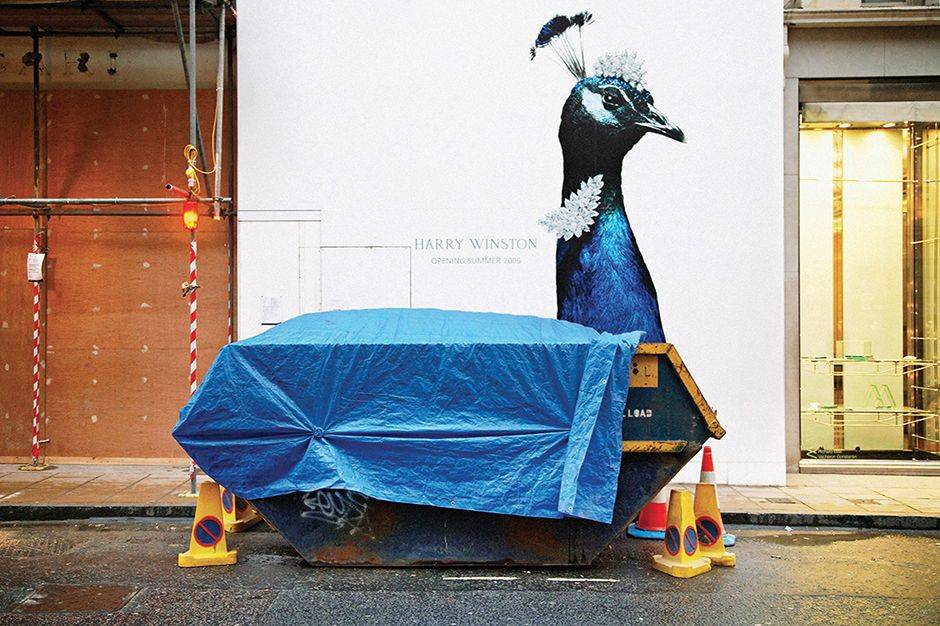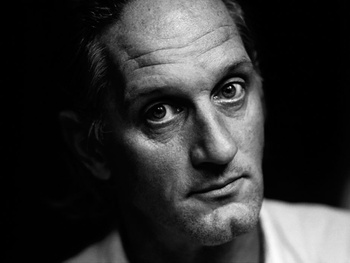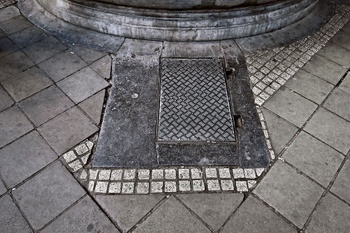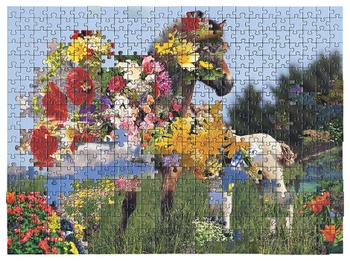Too much beauty kills beauty? In the “Fabulous Failures” exhibition he has curated at the Botanique, which opens on Thursday, the influential Dutch artist and designer Erik Kessels celebrates photographers and other contemporary visual artists who have rejected the aesthetic of perfection in favour of the commonplace, the imperfect, and the failed. #nofilter.

© Matt-Stuart
Erik Kessels embraces the oddities of life with expo in Botanique
The year is 2017 AD. In the era of Facebook and Instagram, the whole planet is subject to the diktats of beauty and perfection. The whole planet? No! One indomitable Dutchman still holds out against the invaders. His name is Erik Kessels. An artist and a collector of photographs, he is also the creative director of the KesselsKramer international communication agency, based in Amsterdam.
For more than fifteen years now, this fascinating and influential individual has applied his talent and his inventiveness to the mission of finding beauty in the commonplace, the strange, and the imperfect. The compiler of some fifty works containing amateur photographs and the editor of a magazine devoted to alternative photography, he also regularly exhibits all over Europe: both his own work and that of others who break with the aesthetic of polished, retouched images – those ultimately identical images that invade our computer and smartphone screens.

When did you start believing in failure?
ERIK KESSELS: Quite a while ago. It has also to do with my background. I am a graphic designer and art director. In my job, I work with a lot of images and technology allows us to approach perfection. We almost need an application to fuck up the photos we make on our phones and make them look more authentic. I have always fought against those clichéd, stereotypical, perfect images in design and advertising.
Perfection is not a good starting point for developing new ideas or new work. It’s just a full stop at the end of the sentence. That triggered my interest in less perfect images. I started visiting flea markets, especially the one in Brussels, looking for amateur images in family albums. I became fascinated with those pictures, because amateurs are much more willing to make mistakes. They don’t care so much about technique; they have a different goal, in a way.
Sometimes I find very special stories. For instance, I once found an album in which a family was trying to photograph their black dog as if they were trying to solve one of the biggest mysteries in photography. They tried it repeatedly. That shows their love for the dog but also their failure, because the black dog is a big black mop in the images.
But then there’s one image where they really start to overexpose the film and then you see that everything is bleached out, but at least you see a little bit of the character of the dog and his eyes. That is an example of something where an amateur has a blind goal and just keeps on going. It is something very nice to see. It’s humorous and at the same time, it shows the dedication of those people. I have always been fascinated by beauty when things fail.
Is that what “Fabulous Failures” is about?
KESSELS: Yes. I first made a book intended for creatives, showing how to embrace failure. This exhibition is more about showing the work of artists I really like who also look for those imperfections. From all kinds of angles. Sometimes literally, sometimes as serendipity. Photographers like Matt Stuart and André Thijssen find those moments of serendipity on the streets. They document mistakes.
Ruth van Beek or Annegien van Doorn just deliberately make mistakes. The Belgian artist Karel De Mulder made a mistake by fuelling his car in a petrol station and forgetting to take the nozzle out. He drove away with the thing still in, ruining the station. He was given a big fine, but he managed to get the camera footage showing what he did wrong, and made an artwork out of that. People can donate some money so he can earn – and not “learn” – from his mistakes. In that way the exhibition is quite playful.
The exhibition was first shown during the Rencontres de la Photographie in Arles last summer. Are we going to see the exact same show at the Botanique?
KESSELS: The setting is the same, but some of the artists have been swapped, in order to highlight the work of Belgian artists. I have been following some of them for a long time: Dries Segers, Sarah Carlier, and David Helbich, for example. Also Leo Gabin, a trio of artists from Ghent. I think they are very good.
In their videos, they play with the stupidity and the stereotypical behaviour of people on the Internet doing make-up tutorials. You have girls who are showing online how perfect they are. So here, in a way, we show the perfection but after a while it becomes really sickening and in the end it has the opposite effect.
(Continue reading below the picture.)

© David Helbich
In Belgium we are quite specialised in failures, especially ones related to construction works. It has become a source of national pride. We like to laugh about it, but it inspires us a lot too.
KESSELS: Sure, you could do the whole exhibition with artists from Belgium! I think those construction failures highlighted by the Belgian artist David Helbich are almost artistic sculptures. They are often beautiful. In Belgium there is also a kind of absurdity that is sometimes embraced. I remember the party that was organised to celebrate 500 days of Belgium having no government [in 2011 – SOS]. Self-irony in Belgium is something very good and I think very nice too. We have that in Holland too, but a lot of countries don’t have it.
You have been publishing and exhibiting pictures showing imperfections for quite a long time now. Have you seen changes in the way your work has been received over that time?
KESSELS: I was quite surprised in the beginning that there was so much attention and it has increased over the years. But I think it also has to do with the fact that the imperfections you find in family albums and analogue photographs are very appealing to people. When you reach the point where everything is perfect, you start to look for something else.
If you take a look at the number of LPs that are being sold again, it has purely to do with the fact that with the CD, the digital file, the sound is perfect, there’s nothing wrong anymore. That’s why people start looking for those kinds of authentic, tactile things.
That’s also the reason why people enjoy going to flea markets, like the one in the centre of Brussels. Do you often visit it?
KESSELS: Now I go every few months maybe, but I used to go more often. I used to go there sometimes the night before and sleep in a hotel on the square, so I could be on there at 6.30–7.00 am, when it was still dark. I found a lot of things there. Berlin, Lisbon, and Madrid are cities that have quite good markets too, but in Brussels I was also really amazed by how many personal belongings you find.
A lot of those fellows on the market empty the houses of people who have died and had no relatives any more. One day, all their belongings, including their letters, banknotes, medical records, X-rays, everything, end up on the market. Unbelievable. In Holland you wouldn’t find that so easily.
Those photographic prints you find have lived a long life before ending up on the flea market. Especially compared to today’s digital pictures that we post on the Internet.
KESSELS: Yes. The life cycle of an image has totally changed. We live in the Renaissance of imagery, meaning that you see more images before lunch than somebody in the eighteenth century saw in their entire life. The pictures that we make today are not there to keep any more or to collect: they are just there to share very quickly in a few hours.
But I am also very positive about those technologies, because they imply a democratisation of photography and design. Everybody can achieve a certain result in a simple way. The thing is that, metaphorically, people are only in the front garden of their houses. The front garden is where you show the end result. A lot of people never go to their back garden, where there’s a mess, where you can make mistakes and nobody sees them, and from them, you can find an idea and end up bringing it to the front garden.
“Fabulous Failures” is an incitement to embrace failure ourselves. What advice would you give our readers, to open their minds to those wonderful mistakes?
KESSELS: To learn to see them, you first need to make them a little bit. We have those navigation systems that bring us exactly where we want to be. But if we deliberately go the wrong way, it gets really crazy. If you go on, it suddenly gives up and then maybe you find something you haven’t seen before: you end up in a village, you have to ask somebody your way; maybe you get to meet somebody nice. Sometimes it’s good to think in the wrong direction.
(Continue reading below the picture.)

© Kent-Rogowsk
FAILURE SUPERHEROES
Technology, retouching software, and hi-tech filters are close to making us forget that to err is human and that without imperfection, there is no charm. Happily, the “Fabulous Failures” exhibition dreamt up by Erik Kessels is there to put us back on the right track. One of the dozen artists on show, Annegien van Doorn from the Netherlands, makes humorous videos bordering on the absurd that focus on everyday objects, such as a tube of toothpaste, that we rarely take the trouble to really look at.
In a similar vein, the Swiss-Danish duo PUTPUT transforms household utensils such as a common or garden sponge into highly aesthetic objets d’art. In the domain of error, Barry van der Rijt from the Netherlands has come up with a DSM (Diagnostic and Statistical Manual of Mental Disorders) applied to anomalies in the field of digital film. Kurt Caviezel from Switzerland collects images from webcams on which we can see surprising situations such as the visits of birds and insects, which give them a surreal character.
Kent Rogowski from New York manipulates mass-produced objects such as jigsaw puzzles and teddy bears to transform them into highly personal works of art. Matt Stuart from London has made a name for himself by photographing amusing and comical situations in the streets, while Brussels-based David Helbich has become a huge hit on Facebook with his hilarious “Belgian solutions”, a homage to the absurd stopgaps one comes across in our urban landscape.
> Fabulous Failures - The Art of Embracing Serendipity and Mistakes. 22/06 > 20/08, Botanique, Sint-Joost-ten-Node
Read more about: Sint-Joost-ten-Node, Expo
Fijn dat je wil reageren. Wie reageert, gaat akkoord met onze huisregels. Hoe reageren via Disqus? Een woordje uitleg.